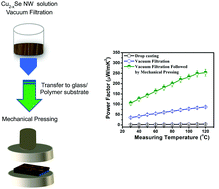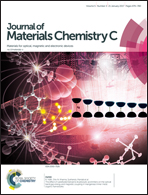Enhanced thermoelectric properties of flexible Cu2−xSe (x ≥ 0.25) NW/polyvinylidene fluoride composite films fabricated via simple mechanical pressing†
Abstract
We report the fabrication of Cu2−xSe NW-polyvinylidene fluoride (PVDF) composite flexible thin films using various approaches such as simple drop casting (DC), vacuum filtration (VF), and vacuum filtration followed by mechanical pressing (VFMP). The highest power factor of Cu2−xSe NW-PVDF composite films reached 105.32 μW m−1 K−2 when mechanical pressing was performed following vacuum filtration at 303 K, and this was further enhanced to 253.49 μW m−1 K−2 at 393 K. Cu2−xSe NW-PVDF composite films fabricated via vacuum filtration without mechanical pressing showed a reasonable power factor (<40 μW m−1 K−2 at room temperature), whereas films fabricated via the drop casting method showed a poor power factor (<10μW m−1 K−2 at room temperature). VFMP-treated Cu2−xSe NW-PVDF thermoelectric films showed good mechanical durability until 1000 bending cycles without significant performance degradation. When all these results are considered, the fabricated composite films could be a feasible option for p-type thermoelectric materials in thermoelectric power generators.



 Please wait while we load your content...
Please wait while we load your content...